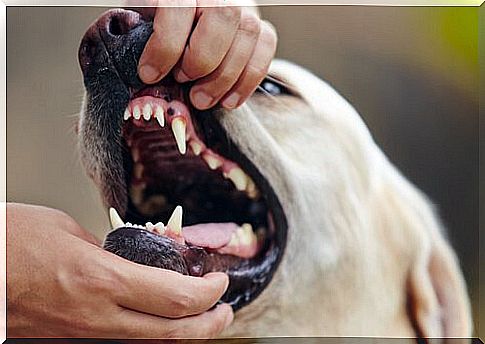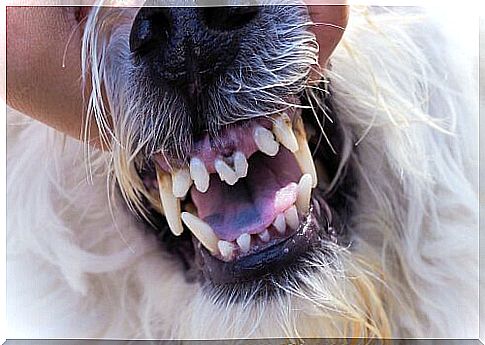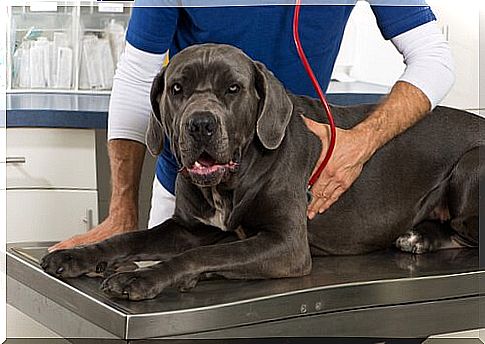The Treatment Of Gingivitis In Pets

Gingivitis is one of the most common oral diseases in pets. It is a progressive inflammatory process that affects the gums and can expand into bone tissue.
Next, we’ll talk about the symptoms and treatment of gingivitis in your pet and also how it can be prevented.
How does gingivitis develop in pets?
A large proportion of oral diseases develop from the formation of bacterial plaque, and gingivitis is no exception. This inflammatory process usually starts when the tartar on the animal’s teeth is not fought off in time. However, let’s take a closer look at how gingivitis occurs to understand its symptoms and treatment.
Some species of bacteria live naturally in dogs’ mouths. When we don’t brush our pets’ teeth, we allow food scraps to accumulate between their teeth and gums. These organic residues serve as food for the bacteria that already live in the animal’s mouth, which allows for their rapid and excessive proliferation.
In this way, an overpopulation of bacteria develops in the animal’s mouth, which leads to their agglomeration in the form of plaques. Bacterial plaques adhere to teeth and, when they react with enamel and saliva, form tartar.
After the tartar adheres to the tooth, the bacteria continue to proliferate and, if not stopped in time, penetrate into the gums. At this time, inflammation of the gums known as gingivitis occurs.

Symptoms of Gingivitis in Pets
Gingivitis usually develops and progresses silently. Its first symptoms are difficult to be diagnosed in pets with the naked eye. Therefore, it is essential to check your pet’s mouth regularly in order to identify any changes.
The first obvious sign of gingivitis is usually the observation of a thin red line at the junction between the teeth and gums. It is also very likely that the gums are red and increase in size. In more advanced cases, abscesses and bleeding may occur.
However, gingivitis can also lead to more complex symptoms, especially when not treated properly. Below, we’ll review other common symptoms of gingivitis in pets:
- Halitosis (bad breath).
- Difficulty chewing.
- Lack of appetite.
- Excessive salivation.
- Frequent attempt to scratch in the mouth region.
- Gingival hyperplasia (excessive enlargement of the gums).
- Do not allow yourself to be touched in the mouth or react negatively when someone tries to do this.
- Behavioral changes, usually associated with pain caused by inflammation.
When gingivitis is not treated in time, bacteria continue to advance and can penetrate the muscle and bone tissue that support the teeth. This can lead to a complex clinical condition called periodontitis or periodontal disease, which can lead to tooth loss.

Gingivitis treatment
When observing any changes in your pet’s mouth, it is essential to go to a veterinary clinic. There, a professional will be able to examine the animal’s mouth and request the necessary tests to check its health status and the progress of bacteria in its body.
The treatment for gingivitis in your pet will fundamentally depend on the stage at which the disease is. As this is a bacterial disease, the use of antibiotics is often essential.
In mild cases, antibiotics are usually applied topically to relieve the inflammatory process and eliminate bacteria. In more advanced cases, antibiotics can be administered orally or intravenously; the idea is to control the proliferation of bacteria in the body.
In addition, the veterinarian may also prescribe pain relievers to relieve pain and thus improve the animal’s quality of life during treatment.
There may also be further surgical intervention to remove tartar from the teeth; in this way, a new case of gingivitis will be avoided. However, the feasibility of this treatment will depend on the animal’s health status.
If the bacteria have reached the bone tissue, the veterinarian must analyze whether the structure of the teeth has been damaged. If advanced deterioration is found, it may be necessary to remove the tooth through surgical intervention.









